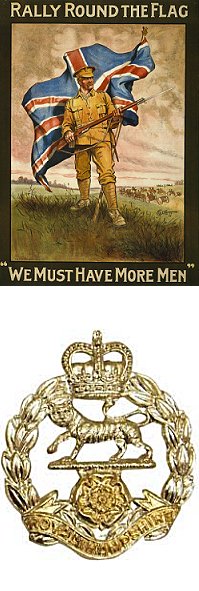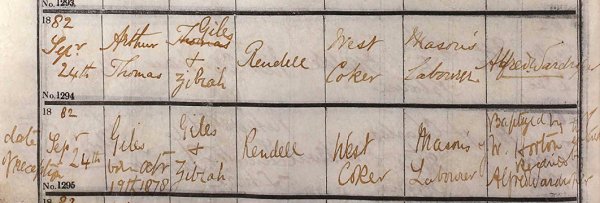yeovil at War
Giles Rendell
Killed in action at the Battle of Messines
Giles Rendell was born in West Coker in 1879, one of the eight children of agricultural labourer, later mason, Giles Rendell (1842-1884) and Zabiah née Hill (1843-1925). In the 1891 census Zabiah, now a pauper, was living in Manor Street, West Coker, with her 23-year old daughter Julia, a domestic servant, sons Herbert and Giles, aged 15 and 12 respectively and both working as agricultural labourers, while 8-year old Thomas was at school. By 1901, still at Manor Street, Zabiah was working as a charwoman while Giles and Thomas were both working as twine makers at Gould's twine factory.
In the winter of 1902, at the age of 23, Giles married Jessie Florence Smith (b1881), originally from Woodstock, Oxfordshire. They moved to Yeovil after their marriage and the 1911 census recorded them at 45 Higher Kingston together with their 6-year old son Denzil (they were later to have another child). Giles gave his occupation as a brewery maltster and is known to have worked at Brutton's Brewery in Clarence Street.
 Giles
enlisted at
Yeovil in June
1916, joining
the Somerset
Light Infantry.
His Service
Number was 26234
- his brother
Arthur (known as
Thomas) had
enlisted on 15
June 1916 and
joined the 7th
(Service)
Battalion,
Somerset Light
Infantry
(Arthur's
Service Number
was 26019).
Giles
enlisted at
Yeovil in June
1916, joining
the Somerset
Light Infantry.
His Service
Number was 26234
- his brother
Arthur (known as
Thomas) had
enlisted on 15
June 1916 and
joined the 7th
(Service)
Battalion,
Somerset Light
Infantry
(Arthur's
Service Number
was 26019).
Giles, however, was soon to transfer to the Machine Gun Section, 15th (Service) Battalion of the Hampshire Regiment. His new Service Number was 27126. This battalion had been in France since early May 1916 and Giles joined them there in October 1916 after the battalion had been in action in the Battle of Flers-Courcelette, a part of the Somme Campaign.
Giles was almost immediately in action at the Battle of the Transloy Ridges (in which his brother Thomas also fought, with the 7th Battalion, Somerset Light Infantry.
The Battle of the Transloy Ridges began in good weather and Le Sars was captured on 7 October. Pauses were made from 8–11 October due to rain and 13–18 October to allow time for a methodical bombardment, when it became clear that the German defence had recovered from earlier defeats. Haig consulted with the army commanders and on 17 October reduced the scope of operations by cancelling the Third Army plans and reducing the Reserve Army and Fourth Army attacks to limited operations in co-operation with the French Sixth Army. Another pause followed before operations resumed on 23 October on the northern flank of the Fourth Army, with a delay during more bad weather on the right flank of the Fourth Army and on the French Sixth Army front, until 5 November. Next day the Fourth Army ceased offensive operations except for small attacks intended to improve positions and divert German attention from attacks being made by the Reserve / Fifth Army.
After the battle Giles, with the 15th Battalion, resumed daily life in the mud of the Somme trenches until his battalion took part in their next set-piece battle, the Battle of Messines.
The Battle of Messines (7–14 June 1917) was an offensive conducted by the British Second Army, under the command of General Sir Herbert Plumer, on the Western Front near the village of Messines in West Flanders, Belgium. The offensive at Messines forced the Germans to move reserves to Flanders from the Arras and Aisne fronts, which relieved pressure on the French. The tactical objective of the attack at Messines was to capture the German defences on the ridge, which ran from Ploegsteert (Plugstreet) Wood in the south, through Messines and Wytschaete to Mount Sorrel, to deprive the German 4th Army of the high ground south of Ypres. The ridge commanded the British defences and back areas further north, from which the British intended to conduct the "Northern Operation", to advance to Passchendaele Ridge, then capture the Belgian coast up to the Dutch frontier.
The battle began with the detonation of a series of mines beneath German lines, which created 19 large craters and devastated the German front line defences. This was followed by a creeping barrage 700 yards (640 m) deep, covering the British troops as they secured the ridge, with support from tanks, cavalry patrols and aircraft. The effectiveness of the British mines, barrages and bombardments was improved by advances in artillery survey, flash-spotting and centralised control of artillery from the Second Army headquarters. The Battle of Messines was a prelude to the much larger Third Battle of Ypres campaign.
Sadly, during the initial advance on 7 June 1917 Giles was hit in the side by shrapnel and died in the arms of his comrade in a shell hole on the battlefield. He was 38 years old.
In its edition of 22 June 1917 the Western Gazette wrote "Information has been received by Mrs. Rendell, of Higher Kingston, that her husband Private Giles Rendell of the Machine Gun Corps was killed in action on the 7th of June. Private Rendell, who was 38 years of age, enlisted under the Derby scheme (actually he wasn't, the Derby scheme was abandoned in December 1915) about 13 months ago. He received his training at Plymouth, and was in the Somerset Light Infantry, but was later transferred to the Machine Gun Corps (sic). Private Rendell had been at the Front since October last, and had seen much heavy fighting. He was a native of West Coker, and was for some years employed at Messrs. Gould’s Twine Factory, but later on coming to Yeovil to live, he worked at Messrs. Brutton’s Brewery. Private Rendell was of a very cheery disposition, and was very popular with his friends in the district. He is the second son of this family to give his life for King and country. Private AT Rendell, of the Somerset Light Infantry died from pneumonia in France almost five months ago. A letter Mrs Rendell has received from her husband’s chum who was with him in the advance made on the 7th, says that Private Rendell was hit in the side by a shrapnel bullet. He was getting up to help another chum that had been hit just before. There were three of them in the same shell hole together. He did all he could for Giles, bandaged him up, and stayed with him until he died. He did not suffer very much, and was sensible up to the last. The writer also went up again the next day and helped to bring him back so that he could assure his wife that he was buried decently. “Giles was well liked by all the boys of the Machine Gun Section who wish to join with me in their sympathy at your great loss.” Private Rendell leaves a widow and two children for whom much sympathy is felt. Mrs. Rendell has received a letter from Priv. Rendell’s commanding officer, which says “It may be some consolation to you to know that he died in the performance of his duty. He was much liked by all who knew him in the company. He is buried in a cemetery well behind the lines and I hope some day to let you know where it is.”
Giles was interred at Bus House Cemetery, West Vlaanderen, Belgium, Grave A22, and his name is inscribed on the War Memorial in the Borough.
Giles' brother Thomas died of pneumonia in France on 2 February 1917 - click here.
gallery

The entries in the West Coker parish register for the baptisms of brothers Arthur and Giles Rendell on 24 September 1882.

The Commonwealth War Graves Commission certificate in memory of Giles Rendell.

Giles Rendell's CWGC headstone in Bus House Cemetery.